
NGC 1512 is a barred spiral galaxy approximately 38 million light-years away from Earth in the constellation Horologium. The galaxy displays a double ring structure, with a (nuclear) ring around the galactic nucleus and an (inner) further out in the main disk. The galaxy hosts an extended UV disc with at least 200 clusters with recent star formation activity. NGC 1512 is a member of the Dorado Group.
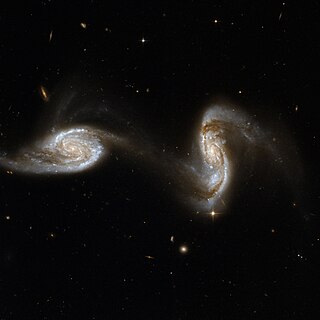
Arp 240 is a pair of interacting spiral galaxies located in the constellation Virgo. The two galaxies are listed together as Arp 240 in the Atlas of Peculiar Galaxies. The galaxy on the right is known as NGC 5257, while the galaxy on the left is known as NGC 5258. Both galaxies are distorted by the gravitational interaction, and both are connected by a tidal bridge, as can be seen in images of these galaxies.
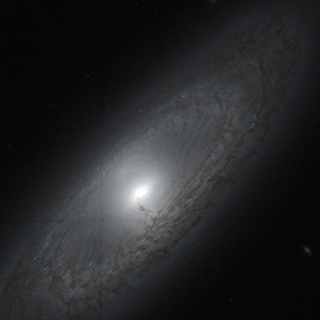
NGC 4448 is a barred spiral galaxy with a prominent inner ring structure in the constellation Coma Berenices.

NGC 4605 is a dwarf barred spiral galaxy in the constellation Ursa Major, located at a distance of 18.1 ± 0.3 megalight-years from the Milky Way. Physically it is similar in size and in B-band absolute magnitude to the Large Magellanic Cloud. It is a member of the M81 Galaxy Group, along with Messier 81 and Messier 101.

NGC 5490 is a large elliptical galaxy located in the constellation of Boötes. Its velocity relative to the cosmic microwave background is 5,075 ± 22 km/s, which corresponds to a Hubble distance of 244.1 ± 17.1 Mly (74.85 ± 5.25 Mpc). In addition, 13 non-redshift measurements gives a distance of 269.98 ± 15.01 Mly (82.777 ± 4.603 Mpc). NGC 5490 was discovered by the German-British astronomer William Herschel on 14 March 1784.

NGC 2082 is a barred spiral galaxy located approximately 60 million light-years away the constellation Dorado. It was discovered November 30, 1834 by John Herschel. The galaxy was originally considered to be part of the Dorado Group of galaxies, but was later removed from the list. NGC 2082 is now considered a member of the nearby NGC 1947 Group which is part of the Southern Supercluster.

NGC 70 is a spiral galaxy located in the constellation Andromeda. It was discovered on October 7, 1855, by R. J. Mitchell and was also observed on December 19, 1897 by Guillaume Bigourdan from France who described it as "extremely faint, very small, round, between 2 faint stars".
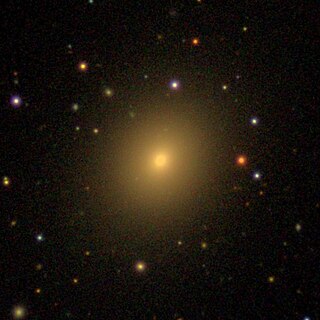
NGC 777 is an elliptical galaxy in the constellation of Triangulum. It was discovered by William Herschel on September 12, 1784. It has a weak active nucleus of type Seyfert 2 or LINER 2, implying that the central region is obscured. It may be an outlying member of galaxy cluster Abell 262.

NGC 498 is a lenticular galaxy located about 260 million light-years away from Earth, in the constellation Pisces. NGC 498 was discovered by astronomer R. J. Mitchell on October 23, 1856.

NGC 2090 is a spiral galaxy located in the constellation Columba. Its velocity with respect to the cosmic microwave background is 994 ± 5 km/s, which corresponds to a Hubble distance of 47.8 ± 3.4 Mly (14.65 ± 1.03 Mpc). However, 51 non-redshift measurements give a distance of 42.46 ± 0.64 Mly (13.018 ± 0.197 Mpc). It was discovered on 29 October 1826 by Scottish astronomer James Dunlop. NGC 2090 was studied to refine the Hubble constant to an accuracy within ±10%.

NGC 7199 is a barred spiral galaxy registered in the New General Catalogue. It is located in the direction of the Indus constellation. It was discovered by the English astronomer John Herschel in 1835 using a 47.5 cm reflector.
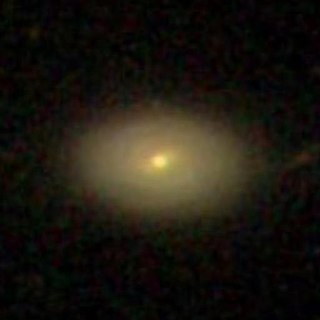
NGC 4060 is a lenticular galaxy located 320 million light-years away in the constellation Coma Berenices. It was discovered by astronomer Albert Marth on March 18, 1865 and is a member of the NGC 4065 Group which is part of the Coma Supercluster.

NGC 4066 is an elliptical galaxy located 340 million light-years away in the constellation Coma Berenices. The galaxy was discovered by astronomer William Herschel on April 27, 1785. NGC 4066 is a member of the NGC 4065 Group.
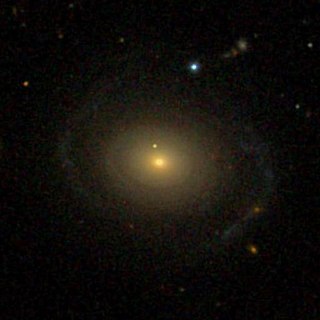
NGC 4086 is a lenticular galaxy located 330 million light-years away in the constellation Coma Berenices. NGC 4086 was discovered by astronomer Heinrich d'Arrest on May 2, 1864 and is a member of the NGC 4065 Group.
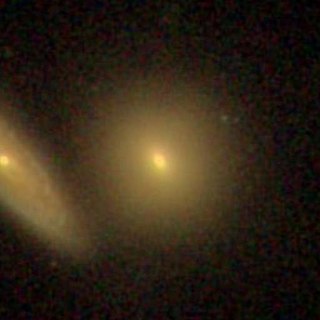
NGC 4089 is an elliptical galaxy located 340 million light-years away in the constellation Coma Berenices. NGC 4089 was discovered by astronomer Heinrich d'Arrest on May 4, 1864 and is a member of the NGC 4065 Group.

NGC 4091 is a spiral galaxy located 360 million light-years away in the constellation Coma Berenices. The galaxy was discovered by astronomer Heinrich d'Arrest on May 2, 1864. NGC 4091 is a member of the NGC 4065 Group and is a LINER galaxy.

NGC 4092 is a spiral galaxy located 310 million light-years away in the constellation Coma Berenices. It was discovered by astronomer Heinrich d'Arrest on May 2, 1864. NGC 4092 is a member of the NGC 4065 Group and hosts an AGN.
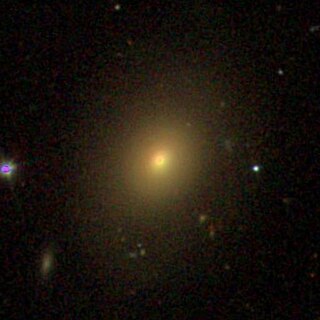
NGC 4095 is an elliptical galaxy located 330 million light-years away in the constellation Coma Berenices. The galaxy was discovered by astronomer William Herschel on April 26, 1785. NGC 4095 is a member of the NGC 4065 Group and is a LINER.

NGC 4221 is a barred lenticular galaxy located about 75.9 million light-years away in the constellation of Draco. It was discovered on April 3, 1832, by the astronomer John Herschel. NGC 4221 is notable for having an outer ring that surrounds the inner barred central region of the galaxy.
The Telescopium−Grus Cloud is a galaxy filament in the constellations of Pavo, Indus, and Telescopium. It was first defined by astronomer Brent Tully in his book The Nearby Galaxies Atlas and its companion book The Nearby Galaxies Catalog.



















